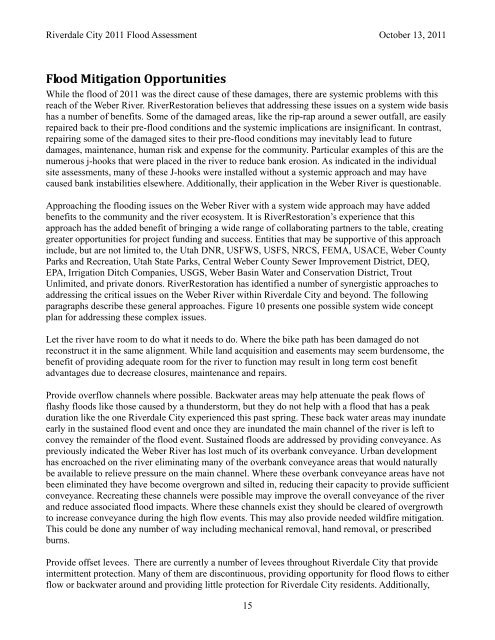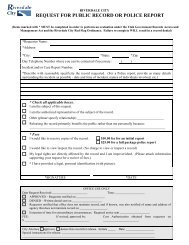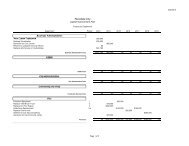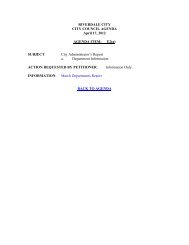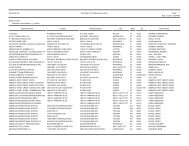Weber River Flood Damage Assessment - Riverdale City
Weber River Flood Damage Assessment - Riverdale City
Weber River Flood Damage Assessment - Riverdale City
You also want an ePaper? Increase the reach of your titles
YUMPU automatically turns print PDFs into web optimized ePapers that Google loves.
<strong>River</strong>dale <strong>City</strong> 2011 <strong>Flood</strong> <strong>Assessment</strong> October 13, 2011<br />
<strong>Flood</strong> Mitigation Opportunities<br />
While the flood of 2011 was the direct cause of these damages, there are systemic problems with this<br />
reach of the <strong>Weber</strong> <strong>River</strong>. <strong>River</strong>Restoration believes that addressing these issues on a system wide basis<br />
has a number of benefits. Some of the damaged areas, like the rip-rap around a sewer outfall, are easily<br />
repaired back to their pre-flood conditions and the systemic implications are insignificant. In contrast,<br />
repairing some of the damaged sites to their pre-flood conditions may inevitably lead to future<br />
damages, maintenance, human risk and expense for the community. Particular examples of this are the<br />
numerous j-hooks that were placed in the river to reduce bank erosion. As indicated in the individual<br />
site assessments, many of these J-hooks were installed without a systemic approach and may have<br />
caused bank instabilities elsewhere. Additionally, their application in the <strong>Weber</strong> <strong>River</strong> is questionable.<br />
Approaching the flooding issues on the <strong>Weber</strong> <strong>River</strong> with a system wide approach may have added<br />
benefits to the community and the river ecosystem. It is <strong>River</strong>Restoration’s experience that this<br />
approach has the added benefit of bringing a wide range of collaborating partners to the table, creating<br />
greater opportunities for project funding and success. Entities that may be supportive of this approach<br />
include, but are not limited to, the Utah DNR, USFWS, USFS, NRCS, FEMA, USACE, <strong>Weber</strong> County<br />
Parks and Recreation, Utah State Parks, Central <strong>Weber</strong> County Sewer Improvement District, DEQ,<br />
EPA, Irrigation Ditch Companies, USGS, <strong>Weber</strong> Basin Water and Conservation District, Trout<br />
Unlimited, and private donors. <strong>River</strong>Restoration has identified a number of synergistic approaches to<br />
addressing the critical issues on the <strong>Weber</strong> <strong>River</strong> within <strong>River</strong>dale <strong>City</strong> and beyond. The following<br />
paragraphs describe these general approaches. Figure 10 presents one possible system wide concept<br />
plan for addressing these complex issues.<br />
Let the river have room to do what it needs to do. Where the bike path has been damaged do not<br />
reconstruct it in the same alignment. While land acquisition and easements may seem burdensome, the<br />
benefit of providing adequate room for the river to function may result in long term cost benefit<br />
advantages due to decrease closures, maintenance and repairs.<br />
Provide overflow channels where possible. Backwater areas may help attenuate the peak flows of<br />
flashy floods like those caused by a thunderstorm, but they do not help with a flood that has a peak<br />
duration like the one <strong>River</strong>dale <strong>City</strong> experienced this past spring. These back water areas may inundate<br />
early in the sustained flood event and once they are inundated the main channel of the river is left to<br />
convey the remainder of the flood event. Sustained floods are addressed by providing conveyance. As<br />
previously indicated the <strong>Weber</strong> <strong>River</strong> has lost much of its overbank conveyance. Urban development<br />
has encroached on the river eliminating many of the overbank conveyance areas that would naturally<br />
be available to relieve pressure on the main channel. Where these overbank conveyance areas have not<br />
been eliminated they have become overgrown and silted in, reducing their capacity to provide sufficient<br />
conveyance. Recreating these channels were possible may improve the overall conveyance of the river<br />
and reduce associated flood impacts. Where these channels exist they should be cleared of overgrowth<br />
to increase conveyance during the high flow events. This may also provide needed wildfire mitigation.<br />
This could be done any number of way including mechanical removal, hand removal, or prescribed<br />
burns.<br />
Provide offset levees. There are currently a number of levees throughout <strong>River</strong>dale <strong>City</strong> that provide<br />
intermittent protection. Many of them are discontinuous, providing opportunity for flood flows to either<br />
flow or backwater around and providing little protection for <strong>River</strong>dale <strong>City</strong> residents. Additionally,<br />
15


